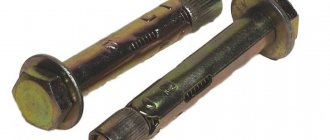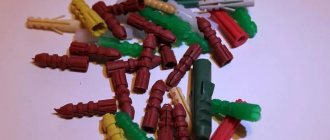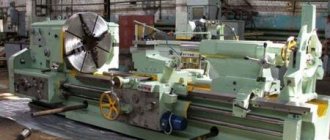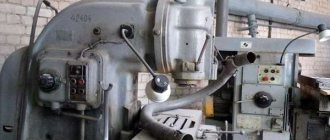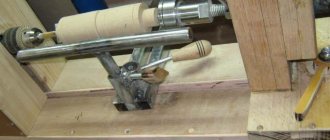Operating principle of a chemical anchor
The operating principle of liquid anchors is simple. A hole with a diameter 2-4 mm larger than the metal element is drilled in the wall or floor. Then the hole is cleaned, filled with adhesive and the fastener is placed there. The substance binds tightly to the metal rod and base, fills all the roughness of the material and hardens, forming a monolithic compound.
Scope of use
The chemical anchor provides increased load-bearing capacity of the connection and is relevant for the following cellular materials characterized by reduced density:
- Foam concrete blocks.
- Shell rock.
- Aerated concrete products.
- Bricks on clinker base.
- Hollow concrete blocks.
Also, high strength of connection is ensured with:
- reinforced concrete;
- brick;
- stone;
- concrete structures.
It is often called liquid or adhesive dowel
The chemical anchor is indispensable to ensure reliable fixation. It applies:
- In dilapidated walls.
- In a humid environment.
- In porous masses.
The hardened composition with metal reinforcement can be installed close to the edge of the structure. It allows you to secure:
- suspended ceilings;
- lighting structures;
- advertising banners located on the facades of buildings;
- structural elements of swimming pools.
An anchor for foam blocks, as well as other types of cellular concrete, provides waterproofing and reliably retains heat.
Composition of chemical anchor
Manufacturers usually do not disclose the exact composition of the chemical anchor, but most often it includes a synthetic resin, a hardener and a filler. Synthetic resin is made from polyester, vinylester, acrylic, polyurethane and other organopolymers. The hardener is necessary for the speed of polymerization of the adhesive composition, and the filler, which is used as quartz sand and cement, is necessary for strength.
The final hardening time of different adhesives varies from several hours to a day. The type and composition of the liquid anchor is selected for a specific task, taking into account loads, base material, climatic conditions and other characteristics.
How to choose a chemical anchor
Positive and negative sides
The advantages of a chemical anchor include:
- ease of installation;
- hole tightness;
- possibility of use indoors due to the absence of hazardous substances;
- wide scope of application;
- high strength;
- possibility of installation in aquatic environments;
- durability.
The listed advantages come with a number of disadvantages. These include:
- high cost;
- short shelf life;
- long hardening process.
Despite their negative aspects, chemical dowels are actively used in construction
Types and installation of chemical anchors
There are two types of chemical anchors: ampoule and injection.
Ampoules are available with one- and two-component compositions. The contents are in a glass capsule. The ampoule is placed in the hole and a fastening element is inserted, which breaks it. The glue sets, and the glass fragments additionally reinforce the connection. For each fastening unit, a new capsule is used, which is selected according to the depth and diameter of the hole. This type of anchor is used for working with dense materials such as solid brick and concrete.
Injection anchors or injection masses are a volumetric cartridge with two compartments filled with different compositions based on organic polymers. The mixer is put on the tube, then it is inserted into a special gun. Injection masses are suitable for working with both solid and hollow bases: concrete, cellular concrete, aerated concrete and expanded clay concrete, porous ceramics, hollow brick, limestone, sandstone and others. Before filling holes in blocks and bricks with voids, a plastic sleeve or metal sleeve is inserted into it, otherwise the adhesive composition will fill large voids in the material.
Video instructions for installing chemical anchors
The best manufacturers
Currently, several well-known companies occupy leading positions in the chemical anchors market. Below is a list of these companies and the technical characteristics of their products.
| (Germany) | ||
| R.M. | “Reaktionsanker” is an ampoule with an adhesive mass, inside of which there is a compartment with a hardener. The manufacturer produces ampoules of different sizes - M8 (10×80), M10 (12×90), M12 (14×110), M16 (18×125), M20 (24×170), M30 (30×280). | |
| FHP | “Hammerpatrone” is an ampoule with glue and hardener for installing metal elements into a concrete base. Produced in the following sizes – 10 (13×90), 12 (15×110), 16 (18×125), 20 (24×180). | |
| FIS V 360S | “Injections-Mortel” Double cartridge, requires a special gun to operate. Main cartridge with a volume of 360 ml and two mixers. | |
| FIS VS 150 | "Injections-Mortel" One standard size cartridge. To work, you will need a regular construction gun for standard cartridges. The kit includes a 150 ml cartridge, two mixers and an adapter. | |
| (Liechtenstein) | ||
| HVU | "Adhisitive Capsule Anchor". Ampoule with methacrylic polyurethane resin, quartz sand and hardener. Capsules have the following volume: M8 (10×80), M10 (12×90), M12 (14×110), M16 (18×125), M20 (24×170), M30 (30×280), M33 (37 ×300), M36 (40×330), M39 (42×360). | |
| HIT-HY150 | "Fast Curinq Injection System". These are two dual cartridges with acrylic resin and hardener. A special gun is required for operation. Cartridge volume 330 ml and two hardeners, HIT-HY20 has one hardener. | |
| HIT-HY20 | ||
| (Switzerland) | ||
| MSP | "Schlagpatrone". Ampoules with resin and hardener. Capsule volume: M8 (10×80), M10 (12×90), M12 (14×110), M16 (18×125), M20 (24×170). | |
| MYA | "Verbunanker". Ampoules with two components. Volume: M8 (10×80), M10 (12×90), M12 (14×110), M16 (18×125), M20 (24×170), M30 (30×280). | |
| MIT-P | One cartridge. A standard construction gun is used for the job. Cartridge volume 150 ml, two mixers. | |
| MIT-P | Double cartridge. Set: 235 ml and two mixers. | |
| MIT-SF | Double cartridge. Volume 380 ml and two mixers. | |
| (Finland) | ||
| KEM | “Kemiallinen ankkuri” – ampoules with polyester resin and hardener, volume M8 (10×80), M10 (12×90), M12 (14×110), M16 (18×125), M20 (24×170), M30 ( 30×280). | |
| KEMLA | “Kemiallinen lyontiampulli” – ampoules with polyester resin and hardener, volume M8 (10×80), M10 (12×90), M12 (14×110), M16 (18×125), M20 (24×170). | |
| ITH | "Injektointitekniika". Cartridge with injection mass based on polyester resin, volume 380 and 150 ml | |
| (Germany) | ||
| TVA | "Verbund-Anker". Ampoules with resin and hardener volume M8 (10×80), M10 (12×90), M12 (14×110), M16 (18×125), M20 (24×170), M30 (30×280). | |
| THP | "Hammerpatrone". Ampoules with resin and hardener, volume M8 (10×80), M10 (12×90), M12 (14×110), M16 (18×125), M20 (24×170). | |
| TVM-K | "Verbundmortel". Cartridge with injection mass, volume 380 and 150 ml. | |
Application areas for chemical anchors
- Fastening and replacement of reinforcement during the construction of critical structures (bridges, floors, stairs, support columns, overpasses, etc.)
- Inserting working reinforcement outlets when building up the foundation, connecting walls, floor slabs, enlarging columns and stairs
- Fixing steel elements
- House construction (installation of roofing, balconies, gates, gazebos, etc.)
- Installation of auxiliary equipment (satellite dishes, plumbing, lanterns, railings, balustrades, etc.)
- Installation of equipment that requires electrical insulation, such as installing handrails in tunnels
- Fastening structures under water and at high humidity
Advantages of chemical anchor
Chemical anchors differ from conventional ones in a number of advantages. Fastenings using injection masses are resistant to vibration, dynamic and static loads. In such connections, the tensile strength is 2-3 times higher than when using mechanical analogues.
Unlike expansion dowels and anchors, chemical ones do not cause stress in the base material, so they can be fastened close to a corner without fear of chipping and cracking, and also leave a minimum distance between the fastening points. No other fastener will provide such a high load when installed in cellular bricks and other hollow and porous materials.
In addition, the chemical anchor fills all cracks and chips in the base and increases the contact area of the metal product with the material, so even if one or more internal partitions are destroyed, the load-bearing capacity is not lost. For this reason, the injection mass is optimal for dilapidated foundations.
It allows you to install fasteners in holes of any configuration, including cone-shaped ones, and use non-standard hardware and fittings. In the case of traditional installation using plastic dowels or wedge metal anchors, only standard product sizes are used. The adhesive does not harden immediately, so the position of the metal rod can be adjusted. This is not possible when working with conventional anchors and dowels. Another advantage is the tightness of the connection and the resistance of chemical anchors to aggressive environments; they are also often used to fix structures under water.
In short, the following features of chemical anchors can be distinguished:
- Suitable not only for threaded fasteners, but also for fittings
- Vibration resistance
- High load-bearing capacity and tensile strength
- Can be used in aggressive environments and underwater
- There are no strict requirements for the shape of the installation hole
- Monolithic connection, equal strength to the base material
- Ideal for porous and hollow materials
- Tightness and durability of the connection (about 50 years according to EU regulations)
- Easy installation without special skills
Did you like the material?
comments powered by HyperComments
Installation instructions
To correctly install chemical anchors with your own hands, you need to carry out a number of operations:
- Preparing the hole. For fastenings that do not require high precision, a hole is drilled with a diameter 1.5-2 times larger than the cross-section of the stud. Regarding critical connections using chemical anchors, the instructions provide clear instructions.
- Dust removal of the hole. To ensure adhesion of the adhesive mass to the base material, the hole is treated with a brush, blown with a pump, a rubber blower, or small particles are removed with a vacuum cleaner. Deep holes are washed with an aqueous solution of PVA and cleaned with compressed air. Mesh bushings are inserted into the cavities of porous structures to uniformly distribute the mixture throughout the volume.
- The installation of capsule and cartridge type anchors is somewhat different. In the first case, an ampoule is placed in the hole, then a pin is inserted and screwed in using a drill at low speeds. Excess solution is removed. In the second, a mixer attachment is put on the tube, installed in a construction gun and inserted into the hole. By pressing the lever, fill the hole 2/3 with the mixture. Then the metal fastener is placed in the glue until it stops. When the length of the hardware is more than 500 mm, a jig with mechanical feed is used.
- After the curing time specified in the instructions, the connection can be used. Usually this is 0.5-10 hours.
Using a chemical anchor is easy, and the benefits of high-quality, durable fasteners are truly great. If it was not possible to buy a ready-made solution, it can be obtained by mixing epoxy resin, plasticizer, cement or gypsum and a hardener.

